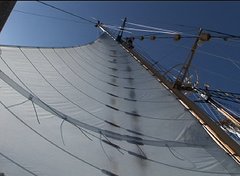Our primary job onboard is standing
watch. The Robert C. Seamans uses the
modified Swedish watch system to divide our days into five blocks of time. The
two daytime watches are six hours long, and the three night watches are four
hours long. Students, mates, and assistant scientists are divided into three
teams, allowing each team to rotate through all five watches every three days.
The watch system takes some getting used to. As around half our work is
completed during hours of darkness, the division between night and day has lost
much of its importance. We eat, sleep, and work at all hours. Captain Pamela
said she feels that each “day” ends up taking 72 hours, the time needed to rotate
through all watch times. This means that the days run together into a patchwork
of darkness, dawn, high noon, and evenings playing music on the quarterdeck.
This
unique schedule also means that our watch groups are the nuclear families of
the larger shipboard community. Though we have an all-hands meeting for
afternoon class each day, it is sometimes difficult to interact with members of
other watches. This division leads to friendly competition between watch
groups, and watches were put to the test by this afternoon’s “line chase”.
On a
ship, ropes that do work are called lines. The Seamans has lines for lifting sails and handling sails, controlling
sampling nets, and raising and lowering the small skiffs. In total, there are
83 lines on the boat! The line chase pitted watches against each other in a
relay race to identify lines.
The
line chase began with the three watches lined up on the back deck. The first
member of each watch was handed an index card with the name of a line, and then
other members of the team were allowed to call “warmer” and “colder” to help
guide their teammate to the correct line. Once the line was identified, the
student walked back to tag off their next teammate. Running was not allowed for
safety’s sake, and racers caught running were required to crab walk all the way
back to the team members. The deck of line cards also contained a few wild
cards. In one instance, the card mandated that the student tell a pickup line to someone in order to identify the
correct line. The game ended when a member of B watch (my watch!) received a
card ordering “congo line”, at which the students danced around the ship in
victory.
While memorizing the location and
function of all 83 lines was arduous, it will enable us to better function as a
team of sailors. We do not use lights on deck at night, so it’s critical that
we can quickly and unthinkingly find lines. The better we know our lines, the
more readily we can take down sails in a wind gust or storm. Our ability to
effectively manage sails will give Captain Pamela the confidence to set more
sails, allowing us to sail faster. For now, we’ll continue our way south, with
an anticipated arrival at Palmyra Atoll on Monday evening.


1 comment:
What a great way to learn about lines and have fun at the same time! Thanks for helping us landlubbers understand a little better what you do.
Post a Comment